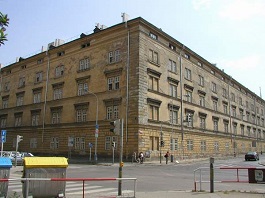
The cultural and social center in the Karlín barracks will probably come to an end
 |
The barracks building has been a protected monument since 1958, and the association has been operating the center in the area since 2017. For example, it has created a gallery, a dance school, a cultural club with a bar, and a daily café in the lobby of the former military pool. The center offers concerts, lectures, and summer cinema screenings practically every day. The association has not managed to negotiate with the state for the acquisition of the extensive barracks building, which is empty.
Until last year, the area fell under the Ministry of Justice, which initially wanted to build a judicial palace there. Eventually, that plan was abandoned, and the properties were taken over by ÚZSVM. "Officials from this agency have negotiated with us extremely correctly and thoroughly regarding our request to extend the contract for several more years," said Velek. Although they requested a five-year extension, they finally agreed with the office on a two-year addendum.
On the same day that the office signed the contract with the center, however, the office announced a tender for a new tenant. This is expected to last until about mid-March, and if ÚZSVM selects a winner and signs a contract, the Prague Center will have to vacate the area within three months and return it to its original condition. Velek stated that the association has invested millions of crowns into the area over the past three years, primarily in the renovation of the smaller building used by the center. He added that the current use is beneficial for the public and the area attracts approximately half a million visitors a year.
According to Velek, the problem lies in the setting of the tender, which does not allow the center to apply for it with its current concept. "From the beginning, we said that if the office issued a tender, we would happily participate because we are quite confident that we would win it," he said. "However, the published tender is, in our view, at least poorly written, as it does not allow the future tenant to do even a fraction of what we do here," he added. According to him, the conditions favor setting up a construction site or warehouses in the area. Velek further stated that if the office does not cancel the tender itself, they will try to negotiate support from politicians to have the office instructed to do so.
ÚZSVM spokesperson Ležatka told ČTK that the office is acting according to the law and has a duty to seek the highest possible return on the properties it manages for the state. In addition to the plan to lease part of the area, the office is currently reaching out to state institutions to see if there is any interest in the area. If no one applies, ÚZSVM plans to seek a private owner, likely through an auction, later this year.
Regarding the competition conditions, Ležatka added that they only point out the possible uses of the properties according to the occupancy permits of individual buildings. "Thus, it is not accurate to say that we do not allow any activities of the existing users," he stated.
Today, an exhibition addressing the history and present of the building, which was constructed between 1845 and 1848, also began in the courtyard of the barracks. The exhibition includes testimonies from eyewitnesses about life in the barracks from the 1970s to the start of the millennium, when the area ceased serving its original purpose.
The English translation is powered by AI tool. Switch to Czech to view the original text source.
0 comments
add comment
Related articles
0
14.02.2025 | The scaffolding from the Karlín Barracks will not disappear, there is a lack of money for the facade repair
0
02.12.2024 | The council of Prague today approved a change to the zoning plan for the Karlin barracks
0
13.06.2024 | Ministerstvo cannot do anything about the closure of the Karlín Barracks, Baxa said
0
04.06.2024 | The Building Authority of Prague 8 has prohibited the activities of the center in Karlín Barracks
0
22.01.2024 | Prague will have an analysis made of the future use of the Karlín barracks
0
19.05.2021 | The center in the former barracks in Prague's Karlín will not close yet
0
24.07.2020 | The office has chosen a new tenant for the Karlín barracks courtyard
0
29.05.2020 | Babiš is considering student dormitories in the Karlín barracks
0
17.02.2020 | <Hřib> Prague is still interested in the Karlín barracks, culture belongs there. </Hřib>
0
13.02.2020 | <a href="#">Kasárna Karlín invite you to the sauna with a glass roof</a>
0
09.10.2019 | The Kasárna Karlín area could be offered in a public auction
0
25.09.2019 | <p>Prague has definitively rejected the possibility of moving officials to the barracks.</p>
0
21.01.2019 | In Prague, two renovations of large former military buildings are being prepared
0
10.04.2017 | The barracks building in Karlín will be occupied by artists; the ministry rented it out
0
05.12.2016 | The Ministry of Justice has acquired the Karlín barracks property












